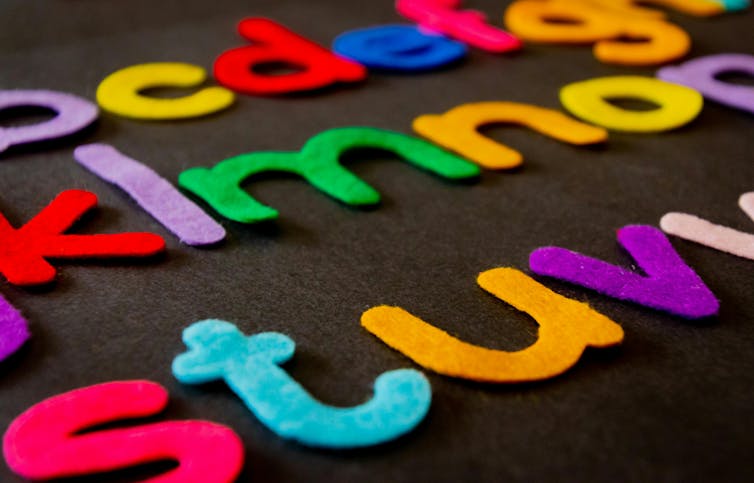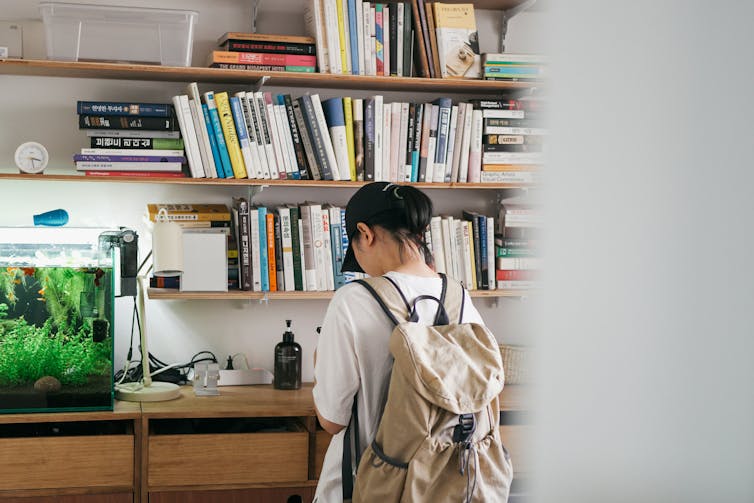
Victoria has just announced all government schools will be required to use phonics to teach reading from next year. This brings it in line with approaches in New South Wales, Queensland and South Australia.
Some Victorian schools already teach phonics. But Education Minister Ben Carroll says all government schools will need to do 25 minutes per day of “explicit teaching” of phonics from the first year of school (called prep in Victoria) to Year 2. Schools will also need to use an approach called “systematic synthetic phonics”.
What do these terms mean and what do they involve?
What is explicit instruction?
Explicit teaching (also called “explicit instruction”) involves introducing complex skills in small steps, with clear explanations and demonstrations of what students are expected to learn.
Students then practice what they learned and get feedback from their teacher until the skill is mastered and a new skill is introduced.
What is phonics?
Phonics is a method of teaching children to read and spell by explicitly teaching students the relationships between letters or letter combinations (also called “graphemes”) and speech sounds (“phonemes”).
Some of the first letters and sounds children learn might be “s”, “a” and “t”. When children know what sounds s, a and t represent, they can spell and sound out “at”, “as” and “sat”.
What is ‘systematic’ phonics?
Phonics teaching is systematic when teachers follow a specific order. Typically, they start with frequent single letters (such as “s”, “a”, “t”, “p”, “i” and “n”) before moving on to frequent sounds with more than one letter (such as “sh”, “th” and “ee”).
The English spelling system is complicated by the fact that many letters and letter combinations can represent more than one sound (for example, “ea” in “heap” and “head”). Phonics teaching covers first the most common relationships between letters and sounds as they can be used to read many new words. Then it covers some of the less frequent relationships.
Research suggests learning 60 to 100 relationships together with some common words with infrequent ones – also called “sight words” or “exception words” – is enough for children to read independently.

What does ‘synthetic’ mean for phonics?
Phonics is taught “synthetically” when it progresses from parts to whole: children learn to sound out each letter or letter combination in a word and then blend those sounds to the pronunciation of the word.
A student who has learned 60 letter-sound relationships can then sound out thousands of new words one letter/letter combination at a time and then blend those sounds into a pronunciation of the whole word. This is called “decoding”.
While initially slow, with practice, decoding becomes quickly automatic.
How else is reading taught?
In Australian schools, synthetic phonics typically replaces “balanced literacy”.
This can include phonics. But it typically presents sounding out – or looking at the letters and parts of words – as one of three methods of figuring out what the new word is.
The other two involve guessing based on what else is happening around the word (such as pictures) or “syntactic cues” (which include the order of words in a sentence). For example, a child may see a sentence “I see a cat” with a picture of a cat. The next sentence might be “I see a dog” with the picture of a dog.
While this approach may intuitively make sense for fluent readers, research shows it is not the way children became fluent readers in the first place.
To become fluent readers, children need to learn to decode first and then use syntactic knowledge and contextual cues to make sense of the text.
Other approaches to phonics
There are also other ways to teach phonics.
One is analytic phonics (also called implicit phonics), which progresses from whole words to their parts. There is also embedded phonics, where students start with books and are taught phonics skills as they are required.
These approaches may not involve explicit teaching about letters and their sounds. And at the moment there is not enough evidence to suggest they work.
Systematic synthetic phonics has the most evidence for being effective in teaching children to decode (or translate the letters to sounds and then blend sounds into words).
Research suggests children with strong early decoding skills are likely to be more interested in reading and read more than those with poorer skills.
In other words, ability drives motivation. Reading more exposes children to new vocabulary and more complex language of books. This then helps them understand academic language as they progress through school.

What can you do at home?
Research also suggests the home environment is important when a child is learning to read. So, how can you support your child as they learn to read using phonics?
First, read to your child interesting books in your home language.
Strong oral language, even if it is not the same as the school language, is important for learning to read and comprehend texts.
Second, ask the teacher what letter-sound combinations your child is learning and to send home books using those for practice.
Third, model simple reading and writing practices. For example, when writing a shopping list, verbalise the sounds in some of the words and the letters you use to write them. Or ask your child to write some of the words that are made of letter-sounds they know. Encourage them to write notes and birthday cards.
Finally, if you notice that your child is struggling to learn letter-sound correspondences or does not gain any fluency, talk with the teacher about additional practice both at school and at home. The earlier children get help, the easier it is to keep up with the rest of their learning.
Rauno Parrila's research on reading has been funded by the Social Sciences Research Council of Canada, Government of Alberta, Alberta Teachers' Association, Australian Research Council, Finnish Academy of Science, and Norwegian Research Council. He is affiliated with the Society of the Scientific Study of Reading and the past Editor-in-Chief of Scientific Studies of Reading.
Anne Castles has received funding from the Australian Research Council and the National Health and Medical Research Council. She is a Fellow of the Academy of Social Sciences in Australia, and is affiliated with the Society for the Scientific Study of Reading.
Saskia Kohnen has received funding from Australian Research Council and the National Health and Medical Research Council. She is affiliated with the Society for the Scientific Study of Reading and is on the board of directors of SPELD NSW.
This article was originally published on The Conversation. Read the original article.







